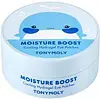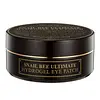What's inside
What's inside
 Key Ingredients
Key Ingredients

 Benefits
Benefits

 Concerns
Concerns

 Ingredients Side-by-side
Ingredients Side-by-side

Water
Skin ConditioningGlycerin
HumectantCarrageenan
Butylene Glycol
HumectantSodium Hyaluronate
HumectantSpirulina Platensis Extract
Skin ProtectingSea Water
HumectantPlankton Extract
Skin ConditioningPhenethyl Alcohol
MaskingCentella Asiatica Extract
CleansingCeratonia Siliqua Gum
EmollientSucrose
HumectantCyamopsis Tetragonoloba Gum
Emulsion StabilisingPotassium Chloride
Polyglyceryl-10 Laurate
Skin ConditioningCalcium Chloride
AstringentAllantoin
Skin ConditioningCellulose Gum
Emulsion StabilisingDipotassium Glycyrrhizate
HumectantCalcium Lactate
AstringentDisodium EDTA
Arginine
MaskingPentylene Glycol
Skin ConditioningCocos Nucifera Fruit Extract
EmollientPinus Sylvestris Leaf Extract
TonicEthyl Hexanediol
Solvent1,2-Hexanediol
Skin ConditioningChlorphenesin
AntimicrobialPropanediol
SolventCaprylyl Glycol
EmollientEthylhexylglycerin
Skin ConditioningSynthetic Fluorphlogopite
Tin Oxide
AbrasiveTitanium Dioxide
Cosmetic ColorantParfum
MaskingWater, Glycerin, Carrageenan, Butylene Glycol, Sodium Hyaluronate, Spirulina Platensis Extract, Sea Water, Plankton Extract, Phenethyl Alcohol, Centella Asiatica Extract, Ceratonia Siliqua Gum, Sucrose, Cyamopsis Tetragonoloba Gum, Potassium Chloride, Polyglyceryl-10 Laurate, Calcium Chloride, Allantoin, Cellulose Gum, Dipotassium Glycyrrhizate, Calcium Lactate, Disodium EDTA, Arginine, Pentylene Glycol, Cocos Nucifera Fruit Extract, Pinus Sylvestris Leaf Extract, Ethyl Hexanediol, 1,2-Hexanediol, Chlorphenesin, Propanediol, Caprylyl Glycol, Ethylhexylglycerin, Synthetic Fluorphlogopite, Tin Oxide, Titanium Dioxide, Parfum
Water
Skin ConditioningGlycerin
HumectantDipropylene Glycol
HumectantNiacinamide
SmoothingCarrageenan
Saccharomyces/Snail Secretion Filtrate Ferment Filtrate
Skin ConditioningButylene Glycol
HumectantCharcoal Powder
AbrasiveGlucose
HumectantPotassium Chloride
Hydroxyethylcellulose
Emulsion StabilisingDiamond Powder
AbrasivePropanediol
SolventSodium Hyaluronate
HumectantPearl Powder
Citrus Unshiu Peel Extract
MaskingP-Anisic Acid
MaskingBeta-Glucan
Skin ConditioningGold
Cosmetic ColorantLevulinic Acid
PerfumingMelaleuca Alternifolia Leaf Water
AntimicrobialEucalyptus Globulus Leaf Extract
PerfumingAlthaea Rosea Flower Extract
Skin ConditioningAloe Barbadensis Leaf Extract
EmollientPunica Granatum Fruit Extract
AntioxidantPorphyra Yezoensis Extract
Skin ConditioningChlorella Vulgaris Extract
Skin ConditioningLaminaria Japonica Extract
Skin ProtectingChamomilla Recutita Flower Extract
MaskingGlycine Soja Phytoplacenta Extract
Skin ConditioningCamellia Sinensis Leaf Extract
AntimicrobialCopper Tripeptide-1
Skin ConditioningDextrin
AbsorbentCeratonia Siliqua Gum
EmollientCyamopsis Tetragonoloba Gum
Emulsion StabilisingMica
Cosmetic ColorantTitanium Dioxide
Cosmetic ColorantIron Oxides
Panthenol
Skin ConditioningArginine
MaskingBee Venom
AstringentEthylhexylglycerin
Skin ConditioningAdenosine
Skin Conditioning1,2-Hexanediol
Skin ConditioningAniba Rosodora Wood Oil
AstringentWater, Glycerin, Dipropylene Glycol, Niacinamide, Carrageenan, Saccharomyces/Snail Secretion Filtrate Ferment Filtrate, Butylene Glycol, Charcoal Powder, Glucose, Potassium Chloride, Hydroxyethylcellulose, Diamond Powder, Propanediol, Sodium Hyaluronate, Pearl Powder, Citrus Unshiu Peel Extract, P-Anisic Acid, Beta-Glucan, Gold, Levulinic Acid, Melaleuca Alternifolia Leaf Water, Eucalyptus Globulus Leaf Extract, Althaea Rosea Flower Extract, Aloe Barbadensis Leaf Extract, Punica Granatum Fruit Extract, Porphyra Yezoensis Extract, Chlorella Vulgaris Extract, Laminaria Japonica Extract, Chamomilla Recutita Flower Extract, Glycine Soja Phytoplacenta Extract, Camellia Sinensis Leaf Extract, Copper Tripeptide-1, Dextrin, Ceratonia Siliqua Gum, Cyamopsis Tetragonoloba Gum, Mica, Titanium Dioxide, Iron Oxides, Panthenol, Arginine, Bee Venom, Ethylhexylglycerin, Adenosine, 1,2-Hexanediol, Aniba Rosodora Wood Oil
 Reviews
Reviews

Ingredients Explained
These ingredients are found in both products.
Ingredients higher up in an ingredient list are typically present in a larger amount.
1,2-Hexanediol is a synthetic liquid and another multi-functional powerhouse.
It is a:
- Humectant, drawing moisture into the skin
- Emollient, helping to soften skin
- Solvent, dispersing and stabilizing formulas
- Preservative booster, enhancing the antimicrobial activity of other preservatives
Arginine is an amino acid that is important for human development. Your body uses is it to produce hair keratin and skin collagen.
As a cosmetic ingredient, Arginine has antioxidant properties and can also help repair damaged skin. This ingredient is derived either synthetically or from animals.
Arginine isn't fungal acne safe when used in the presence of other lipids (fats, fatty acids, oils, esters, etc). Oils and fats occur naturally within the skin, so take caution when using Arginine if you're prone to fungal acne.
Learn more about ArginineButylene Glycol (or BG) is used within cosmetic products for a few different reasons:
Overall, Butylene Glycol is a safe and well-rounded ingredient that works well with other ingredients.
Though this ingredient works well with most skin types, some people with sensitive skin may experience a reaction such as allergic rashes, closed comedones, or itchiness.
Learn more about Butylene GlycolCarrageenan comes from red seaweed or algae. It is made up of polysaccharides and a highly flexible compound. Red algae cell walls are rich in carrageenan.
In cosmetics, it helps to thicken the texture. Studies show carrageenan extracted from red algae possess antioxidant properties. Components found in carrageenan include: lipids, fatty acids, Vitamin E, proteins, and several amino acids.
Learn more about different types of algae.
Carrageenan is also commonly used in medicine and food. It is a vegan alternative to animal-based gelatin.
Learn more about CarrageenanCeratonia Siliqua Gum is extracted from the seeds of the carob tree. You might know this ingredient as Carob Gum or Locust Bean Gum. It is used to stabilize other ingredients and improve the texture of products.
Carob gum is made up of long-chain polysaccharides. This makes it a natural thickener.
Yes! This ingredient comes from the seeds of a tree. The name 'Locust Bean Gum' can be misleading.
Learn more about Ceratonia Siliqua GumGuar gum is made from the guar bean, a plant native to India. It is considered a form of polysaccharide and naturally contains sugar.
This ingredient is often used to thicken a product or create a gel-like consistency.
It also has emulsion properties to help keep ingredients together.
Learn more about Cyamopsis Tetragonoloba GumEthylhexylglycerin (we can't pronounce this either) is commonly used as a preservative and skin softener. It is derived from glyceryl.
You might see Ethylhexylglycerin often paired with other preservatives such as phenoxyethanol. Ethylhexylglycerin has been found to increase the effectiveness of these other preservatives.
Glycerin is already naturally found in your skin. It helps moisturize and protect your skin.
A study from 2016 found glycerin to be more effective as a humectant than AHAs and hyaluronic acid.
As a humectant, it helps the skin stay hydrated by pulling moisture to your skin. The low molecular weight of glycerin allows it to pull moisture into the deeper layers of your skin.
Hydrated skin improves your skin barrier; Your skin barrier helps protect against irritants and bacteria.
Glycerin has also been found to have antimicrobial and antiviral properties. Due to these properties, glycerin is often used in wound and burn treatments.
In cosmetics, glycerin is usually derived from plants such as soybean or palm. However, it can also be sourced from animals, such as tallow or animal fat.
This ingredient is organic, colorless, odorless, and non-toxic.
Glycerin is the name for this ingredient in American English. British English uses Glycerol/Glycerine.
Learn more about GlycerinPotassium Chloride can be bad for oily skin and be bad for acne prone skin.
Propanediol is an all-star ingredient. It softens, hydrates, and smooths the skin.
It’s often used to:
Propanediol is not likely to cause sensitivity and considered safe to use. It is derived from corn or petroleum with a clear color and no scent.
Learn more about PropanediolSodium Hyaluronate is hyaluronic acid's salt form. It is commonly derived from the sodium salt of hyaluronic acid.
Like hyaluronic acid, it is great at holding water and acts as a humectant. This makes it a great skin hydrating ingredient.
Sodium Hyaluronate is naturally occurring in our bodies and is mostly found in eye fluid and joints.
These are some other common types of Hyaluronic Acid:
Learn more about Sodium HyaluronateTitanium dioxide is a mineral UV filter widely used in sunscreens and cosmetics.
It is one of only two UV filters officially classified as “mineral” by regulatory agencies, the other being zinc oxide.
Titanium dioxide provides broad-spectrum protection mostly in the UVB and UVAII range, with some protection in the UVAI range.
While its UVA protection isn’t as strong as zinc oxide’s, the difference is minor.
A common myth is that mineral UV filters reflect UV light. However, modern research shows titanium dioxide absorbs UV radiation like chemical filters (~95% absorption & 5% reflection).
Thanks to its non-irritating nature, titanium dioxide is suitable for sensitive, acne-prone, or redness-prone skin. It is unlikely to cause "eye sting" like other sunscreen ingredients.
A major drawback of this ingredient is its white cast and thick texture. This is why mineral sunscreens often leave a white cast and are less cosmetically elegant than chemical/hybrid sunscreens.
To improve white cast and spreadability, micronized or nano-sized titanium dioxide is often used.
There are ongoing concerns surrounding nano-titanium oxide's impact on marine ecosystems.
There is no conclusive evidence that any form of titanium oxide (or any other sunscreen ingredients) will cause harm to marine ecosystems or coral reefs. The science is still developing but many consumers are keeping a close eye on this issue.
Please note, many destinations have reef-safety sunscreen rules. For instance, the U.S. Virgin Islands advises all visitors to use non-nano mineral sunscreens.
Nano mineral sunscreens once raised safety concerns about absorption into skin.
Extensive research has shown that they do not penetrate healthy or damaged skin; they remain safely on the surface and the top layer of dead skin (stratum corneum).
You'll likely find titanium dioxide bundled with alumina, silica, or dimethicone. These ingredients help make titanium dioxide highly photostable; this prevents it from interacting with other formula components under UV light.
Learn more about Titanium DioxideWater. It's the most common cosmetic ingredient of all. You'll usually see it at the top of ingredient lists, meaning that it makes up the largest part of the product.
So why is it so popular? Water most often acts as a solvent - this means that it helps dissolve other ingredients into the formulation.
You'll also recognize water as that liquid we all need to stay alive. If you see this, drink a glass of water. Stay hydrated!
Learn more about Water